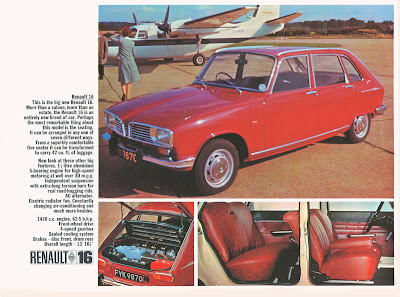
from a 1967 Renault brochure
While I have previously written about Citroën’s ingeniously designed 2CV, and their spaceship-like CX, the only Citroën my family has owned was a Xsara MPV, or “people carrier” – remember them? – that licensed the name of Pablo Picasso, presumably to mean something.
However, the only car my family has owned more than once – we had two of them – was also French. Made from 1965 to 1980 in a factory near Le Havre, the Renault 16 was one of the first imported cars to sell in big numbers in the UK, a country that rarely bought from outside its own shores before then – we later benefitted from the second-hand market it opened.
As a child, I remember it being big, roomy and comfortable. The ride was also very smooth, which I now know is due to independent rear suspension using torsion bars that spanned the width of the car, requiring the rear right wheel to be placed slightly forward of the left rear wheel. One of the few front-wheel drive cars on sale in 1965, and with its gearbox placed in front of its aluminium engine, there was no transmission, gearstick or handbrake invading the interior space and separating the front seats. Instead, the handbrake was a pull-out lever under the steering wheel, and the gearstick grew out of the steering column. Oddly, the windscreen washers were activated using a button on the floor, near the clutch.
The 16 was Renault’s biggest and most luxurious car when it went on sale, competing with the Ford Cortina and the Austin/Morris 1800, and made various features available in a family car for the first time, like central locking, powered sunroof and driver windows, and air conditioning. Just as taken for granted in new cars today was the split rear bench seats, with many advertisements for the 16 displaying the sheer amount of luggage it could hold.
This leads to the ultimate innovation of the Renault 16. It was not the first car to have a “hatchback”: Citroën had the “Commerciale” variant of its Traction Avant, and various Austin and Morris cars, included the Mini, had “Countryman” versions that had single or split rear hatches. Even the small Renault 4, the 2CV competitor introduced four years before the 16, had what would be described as a hatchback.
However, all these cars were usually described as estate cars, or station wagons. The Renault 16, with its rear more raked than squared off, and with a tall profile and large windows, fell between a standard saloon and an estate car. “An entirely new breed of car” was what its brochure said, but only Renault’s American division branded it as the “Sedan-Wagon” during its short time on sale there. I guess as a family, we didn’t think anything of it because most new cars were hatchbacks by the time we had our first 16, the avant-garde having become the standard.
According to www.howmanyleft.co.uk, only eighty Renault 16s remain on British roads as of August 2024. How many cars influenced by it remain? Millions.

No comments:
Post a Comment